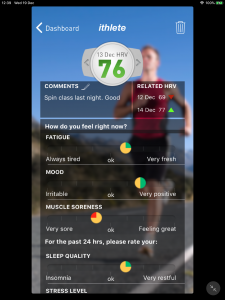There are many great reasons to choose ithlete, so many that we’ve written a blog series looking at why we do things the way we do. Follow the series to learn more about the type and length of measurement, how breathing influences your HRV and much more.
Using wellness metrics to add context to your HRV number
After they first get ithlete, a lot of people enjoy recording their heart rate variability (HRV) every day. Watching the number fall after hard training, followed by a rebound a day or two later can be very satisfying. They also soon notice the impact of a late night for example, or a short illness. But it’s not always that simple to interpret the cause of changes. With HRV, like many things, the more you put in, the more you get out. By using the ithlete wellness sliders, adding comments and recording training loads you can add important context to your data.
 After your morning HRV reading ithlete encourages you to record the six most commonly used metrics used in training monitoring:
After your morning HRV reading ithlete encourages you to record the six most commonly used metrics used in training monitoring:
- Fatigue
- Mood
- Muscle soreness
- Sleep quality
- Stress management
- Dietary compliance
The first three are purely subjective, reflecting how you feel, whilst the last three are what we call ‘recovery enablers’. These are factors that you can influence to a large extent, thereby helping (or hindering!) your recovery. The better you take care of these, the more able you will be to cope with higher training loads (more on that here). A sleep score can be imported from Fitbit or Garmin watches that are worn during the night to make this even easier too.
Whilst working on the Simon Says artificial intelligence feature of ithlete Pro, one of the many things we learned working with the University of Edinburgh analyzing the data of hundreds of ithlete users, was that people tend to use only a small part of the range of these metrics. To address this we now show yesterday’s score dimmed behind the sliders, allowing you more easily to judge relative changes from one day to the next. Recording the Wellness metrics as accurately and honestly as possible helps you to identify which lifestyle factors are most affecting your recovery, therefore your ability to cope with high training loads, whilst remaining healthy.
Whilst you can try to identify relations between wellness metrics using the app’s charts, the Simon Says AI identifies the most likely reasons for changes in your HRV, not only from day to day, but trends over longer periods too.

Any chance this would work with Suunto as well?
Hi John,
Do you mean the Suunto HRM chest strap? If so, likely yes! We have a list of compatible HRM straps here.
Our app isn’t compatible with any wrist base devices though.
Best, Laura